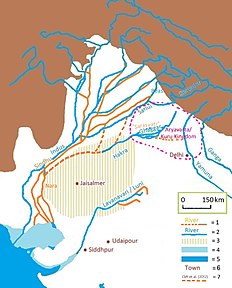
Back نهر لونى ARZ लूनी नदी Bihari লুনি নদী Bengali/Bangla Lūni River (suba sa Indiya) CEB Luni (Fluss in Rajasthan) German Luni (rivière) French લુણી નદી Gujarati लूणी नदी Hindi Լունի (գետ) Armenian ലൂണി നദി Malayalam
| Luni River Sagarmati | |
|---|---|
 Course of River Luni or Lavanaravi river, south of the estimated route of the ancient Sarasvati river | |
| Native name | |
| Location | |
| Country | India |
| State | Rajasthan |
| Physical characteristics | |
| Source | |
| • location | Pushkar Valley near Ajmer |
| • elevation | 550 m (1,800 ft) |
| Mouth | |
• location | Gujarat |
• coordinates | 24°39′N 71°11′E / 24.650°N 71.183°E |
| Length | 495 km (308 mi) |
| Basin size | 37,363 km2 (14,426 sq mi) |
| Basin features | |
| Cities | Birami, Raipur |
| Tributaries | |
| • left | Jawai River, Sukri River, Guhiya River, Bandi River, Liladi River |
| • right | Jojari River |
The Luni is the largest river in the Thar Desert in Northwest India.[1] It originates in the Pushkar valley of the Aravalli Range, near Ajmer, passes through the southeastern portion of the Thar Desert, and ends in the marshy lands of Rann of Kutch in Gujarat, after travelling a distance of 495 km (308 mi). It is first known as Sagarmati, then after passing Govindgarh, it meets its tributary Sarasvati, which originates from Pushkar Lake and from then on it is called Luni.[2]
In 1892, Maharaja Jaswant Singh II of Jodhpur constructed 0 in Pichiyak village between Bilara and Bhawi of Jodhpur district. It is one of the largest artificial lakes in India and irrigates more than 12,000 acres (49 km2).[2] It is one of the internal drainage rivers in India; it does not meet with Arabian Sea. It is drained before it reaches the Arabian Sea.
- ^ Carling, Paul A.; Leclair, Suzanne F. (16 July 2018). "Alluvial stratification styles in a large, flash-flood influenced dryland river: The Luni River, Thar Desert, north-west India". Sedimentology. 66 (1): 102–128. doi:10.1111/sed.12487. ISSN 0037-0746.
- ^ a b Luni River, The Imperial Gazetteer of India. Vol. 16. 1909. pp. 211–212., see also The Imperial Gazetteer of India
© MMXXIII Rich X Search. We shall prevail. All rights reserved. Rich X Search
